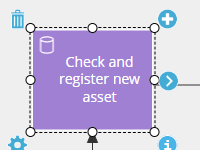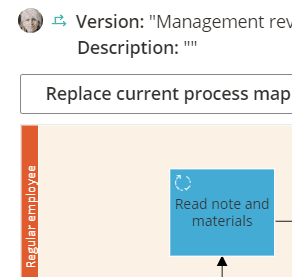
Process improvement process steps: An introduction

Process improvement is a crucial aspect of any successful organization. It involves identifying areas that can be enhanced, defining goals and objectives, collecting and analyzing data, developing improvement plans, implementing those plans, measuring and monitoring results, and finally, continuously improving strategies. In this article, we will delve into each of these process improvement steps, highlight common pitfalls to avoid, and provide insights on how to maximize success in this essential area of business.
Table of contents
- Step 1: Identifying the Need for Improvement
- Step 2: Defining the Goals and Objectives
- Step 3: Collecting and Analyzing Data
- Step 4: Developing the Improvement Plan
- Step 5: Implementing the Improvement Plan
- Step 6: Measuring and Monitoring Results
- Continuous Improvement Strategies
- Common Pitfalls to Avoid
- Conclusion
- Frequently Asked Questions
Looking for something else? Explore these related articles:
Step 1: Identifying the Need for Improvement
Recognizing the need for improvement is the first step towards enhancing efficiency and effectiveness. This involves conducting a thorough evaluation of existing processes and systems to identify areas that are underperforming, causing bottlenecks, or failing to meet the desired outcomes.
During the evaluation process, it is essential to gather relevant data and metrics to gain a comprehensive understanding of the current state. This data can include performance indicators, customer feedback, employee surveys, and market research. By analyzing this information, organizations can pinpoint specific areas that require improvement.
Once the underperforming areas have been identified, organizations can prioritize and strategize the improvement efforts. This involves setting clear goals and objectives for each area, as well as developing a detailed plan of action. The plan should outline the steps to be taken, the resources required, and the timeline for implementation.
Furthermore, it is important to involve key stakeholders, such as employees and customers, to gain insights into their needs and expectations. Their feedback can provide valuable input for identifying areas that require immediate attention. By engaging stakeholders in the improvement process, organizations can ensure that the solutions implemented are aligned with their needs and will have a positive impact.
In addition to involving stakeholders, organizations can also consider seeking external expertise to assist in the identification of improvement opportunities. Consultants or industry experts can provide a fresh perspective and bring in-depth of best practices and innovative solutions.
Moreover, organizations can leverage technology to aid in the identification of improvement areas. Advanced analytics tools can analyze large volumes of data and identify patterns or trends that may not be immediately apparent. This can help organizations uncover hidden inefficiencies or bottlenecks that may be hindering performance.
Overall, identifying the need for improvement requires a comprehensive and systematic approach. By evaluating existing processes, involving stakeholders, seeking external expertise, and leveraging technology, organizations can gain a deeper understanding of their current state and identify areas for enhancement.
”If you can’t describe what you are doing as a process, then you don’t know what you are doing.”
W. Edwards Deming

Step 2: Defining the Goals and Objectives
Once the need for improvement has been identified, the next step is to clearly define the goals and objectives that the organization aims to achieve. These goals should be specific, measurable, attainable, relevant, and time-bound (SMART). By setting SMART goals, organizations can ensure that their improvement efforts are focused, actionable, and aligned with their overall strategic objectives.
When defining the goals and objectives, it is crucial to consider the current state of the organization and its desired future state. This involves conducting a thorough analysis of the internal and external factors that may impact the organization’s performance and success. By understanding the strengths, weaknesses, opportunities, and threats, organizations can identify areas for improvement and set goals that address these areas effectively.
Furthermore, involving key stakeholders in the goal-setting process is essential. This includes individuals from various levels and departments within the organization, as well as external stakeholders such as customers, suppliers, and partners. By involving a diverse group of stakeholders, organizations can gain different perspectives and insights, leading to more comprehensive and well-rounded goals and objectives.
Once the goals and objectives have been defined, it is important to communicate them effectively to all stakeholders involved. This can be done through various means, such as town hall meetings, departmental meetings, email updates, and intranet platforms. The communication should be clear, concise, and consistent, ensuring that everyone understands the purpose, importance, and expected outcomes of the improvement efforts.
Moreover, it is crucial to create a shared understanding and sense of purpose among all stakeholders. This can be achieved through open and transparent communication, fostering a culture of collaboration and commitment towards the improvement process. By involving stakeholders in the goal-setting process and providing regular updates on progress, organizations can create a sense of ownership and accountability, motivating individuals to actively contribute to the achievement of the goals and objectives.
In conclusion, defining the goals and objectives is a critical step in the improvement process. It involves considering the current state of the organization, conducting a thorough analysis, involving key stakeholders, and effectively communicating the goals and objectives. By following these steps, organizations can ensure that their improvement efforts are focused, aligned, and ultimately successful in driving positive change and achieving desired outcomes.
👉 Recommendation: Prioritize collaboration and inclusivity in goal-setting by involving a diverse group of stakeholders. Ensure goals are SMART, aligned with strategic objectives, and address identified areas for improvement. Communicate goals transparently through various channels, fostering a culture of accountability and collaboration. Regularly update stakeholders on progress to maintain engagement and momentum in achieving organizational improvement.
Step 3: Collecting and Analyzing Data
Data collection and analysis play a critical role in the process improvement journey. This involves gathering relevant data from various sources, such as customer feedback, performance metrics, and process documentation. By systematically analyzing this data, organizations can gain valuable insights into the root causes of existing problems and bottlenecks.
One of the key sources of data for organizations is customer feedback. By actively seeking feedback from customers, organizations can understand their needs, preferences, and pain points. This feedback can be collected through surveys, interviews, or even social media listening. Analyzing this feedback can provide organizations with a deeper understanding of customer expectations and help identify areas where improvements can be made.
In addition to customer feedback, organizations also rely on performance metrics to collect data. These metrics can include key performance indicators (KPIs) such as customer satisfaction scores, cycle time, and defect rates. By tracking these metrics over time, organizations can identify trends and patterns that indicate areas for improvement. For example, if the customer satisfaction score has been consistently low, it may indicate a need to improve the quality of products or services.

Try Gluu for free
Sign up for a 30-day trial.
No credit card required.
Process documentation is another valuable source of data for organizations. This includes standard operating procedures, work instructions, and process flowcharts. By reviewing these documents, organizations can identify inefficiencies, redundancies, and bottlenecks in their processes. This information can then be used to prioritize improvement initiatives and streamline operations.
Utilizing tools and techniques such as process mapping, statistical analysis, and benchmarking, organizations can identify patterns, trends, and areas for improvement. Process mapping involves visually representing the steps and interactions involved in a process. This helps organizations understand the flow of activities and identify areas where delays or errors may occur.
Statistical analysis involves applying statistical methods to analyze data and draw conclusions. This can include techniques such as regression analysis, hypothesis testing, and correlation analysis. By using statistical analysis, organizations can identify relationships between variables and make data-driven decisions.
Benchmarking is another valuable technique for data analysis. This involves comparing an organization’s performance against industry standards or best practices. By benchmarking, organizations can identify areas where they are lagging behind and learn from others who have achieved superior performance.
This data-driven approach enables informed decision-making and helps prioritize improvement initiatives based on their potential impact and feasibility. By collecting and analyzing data from various sources, organizations can gain a holistic view of their processes and make targeted improvements to drive efficiency and customer satisfaction.
Examples of features for process improvement process steps

Simple process mapping
Map using five basic shapes for easier understanding by end users.

Import processes
Copy/paste multiple processes to Gluu for quick transfer.
Step 4: Developing the Improvement Plan
With goals defined and data analyzed, organizations can now develop a comprehensive improvement plan. This plan should outline the specific actions, resources, and timelines required to achieve the desired results. It should also specify key performance indicators (KPIs) that will be used to evaluate the success of the improvement efforts.
Engaging cross-functional teams in the development of the improvement plan can provide diverse perspectives and ensure buy-in from all stakeholders. In addition, organizations should consider implementing lean or agile methodologies to facilitate continuous improvement and adaptability.
One important aspect of developing the improvement plan is to identify the root causes of the issues or challenges that the organization is facing. This can be done through various methods such as conducting root cause analysis, brainstorming sessions, or utilizing process mapping techniques. By understanding the underlying causes, organizations can develop targeted strategies to address them effectively.
Furthermore, it is crucial to consider the resources required to implement the improvement plan. This includes not only financial resources but also human resources, technology, and infrastructure. Organizations should assess their current capabilities and identify any gaps that need to be filled in order to successfully execute the plan.
Another key element of the improvement plan is establishing clear and realistic timelines. This involves breaking down the overall goals into smaller, manageable tasks with specific deadlines. By setting achievable milestones, organizations can track progress and ensure that the improvement efforts stay on track.
Additionally, organizations should determine the key performance indicators (KPIs) that will be used to measure the success of the improvement plan. These KPIs should be aligned with the goals and objectives of the organization and provide meaningful insights into the progress being made. Examples of KPIs could include customer satisfaction ratings, reduction in defects or errors, increase in productivity, or cost savings.
When developing the improvement plan, it is essential to involve cross-functional teams from different departments or areas of expertise. This ensures that a diverse range of perspectives and ideas are considered, leading to a more comprehensive and effective plan. By involving stakeholders from various levels of the organization, there is a higher likelihood of achieving buy-in and support for the improvement efforts.

Try Gluu for free
Sign up for a 30-day trial.
No credit card required.
Furthermore, organizations should consider implementing lean or agile methodologies in the development and execution of the improvement plan. These methodologies emphasize continuous improvement, adaptability, and collaboration. By adopting lean principles, organizations can identify and eliminate waste, streamline processes, and improve overall efficiency. Agile methodologies, on the other hand, focus on iterative and incremental development, allowing for flexibility and quick adjustments based on feedback and changing circumstances.
In conclusion, developing a comprehensive improvement plan involves identifying root causes, allocating necessary resources, setting realistic timelines, and establishing meaningful KPIs. Engaging cross-functional teams and considering lean or agile methodologies can enhance the effectiveness of the plan. By taking a systematic and strategic approach, organizations can drive positive change and achieve their desired results.
Step 5: Implementing the Improvement Plan
The success of any improvement plan depends on effective implementation. This involves executing the identified actions and changes, as outlined in the improvement plan. Clear communication channels and ongoing support from leadership are crucial during this phase to ensure that employees understand the changes, their roles, and the expected outcomes.
Moreover, organizations should invest in training programs to equip employees with the necessary skills and knowledge required for the new processes. Regular feedback and open communication should be encouraged to address any challenges or resistance that may arise during implementation.
👉 Recommendation: Prioritize clear communication and leadership support during implementation. Establish training programs to equip employees with the skills needed for new processes. Encourage regular feedback and open communication channels to address challenges and resistance. Ensure that the organization remains agile and adaptable throughout the implementation phase, making adjustments as needed based on real-time feedback and changing circumstances.
Step 6: Measuring and Monitoring Results
Once the improvement plan has been implemented, it is important to measure and monitor the results to determine the effectiveness of the changes made. This involves tracking the identified KPIs and comparing them against the baseline data collected earlier.
Organizations can utilize various performance measurement tools, such as dashboards and scorecards, to visualize and communicate the progress made. Regular reviews and analysis can help identify any deviations or areas that require further attention, leading to timely corrective actions.
Continuous Improvement Strategies
Process improvement is not a one-time project; instead, it should be viewed as an ongoing journey towards excellence. Organizations should adopt continuous improvement strategies to instill a culture of innovation and learning.
This can be achieved by establishing feedback loops, encouraging employee suggestions, and regularly reviewing and updating processes to adapt to changing business needs. Additionally, organizations can leverage technologies such as automation and artificial intelligence to enhance efficiency and streamline operations.
Common Pitfalls to Avoid
While pursuing process improvement, organizations may encounter common pitfalls that can hinder their progress. One of the major pitfalls is a lack of leadership support and involvement. Clear and visible support from leaders is vital to ensure the successful implementation and sustainability of improvement initiatives.
Another pitfall is a failure to communicate and engage stakeholders effectively. By neglecting to involve employees and other relevant parties in the improvement process, organizations risk resistance, lack of ownership, and the potential failure of the intended improvements.
Furthermore, organizations should be cautious of over-ambitious goals or attempting to tackle too many improvement initiatives simultaneously. This can potentially overwhelm resources, dilute focus, and result in suboptimal outcomes.
Conclusion
Process improvement is a continuous journey that empowers organizations to enhance their operations, deliver exceptional customer experiences, and achieve strategic objectives. By following the process improvement steps outlined in this article, organizations can drive positive change, optimize efficiency, and foster a culture of continuous improvement.
Remember, identifying the need for improvement, defining clear goals, collecting and analyzing data, developing an improvement plan, implementing changes, measuring results, adopting continuous improvement strategies, and avoiding common pitfalls are key elements to a successful process improvement journey. Embracing these steps will help organizations not only survive but thrive in today’s dynamic and competitive business landscape.
Frequently Asked Questions
Process improvement typically follows the DMAIC model, which stands for Define, Measure, Analyze, Improve, and Control. These stages guide organizations through a systematic approach to identify and enhance processes. It starts with defining the problem or opportunity, measuring the existing process, analyzing data to understand root causes, making improvements, and finally, implementing controls to sustain improvements.
The 7 steps of the improvement process often refer to the Plan-Do-Check-Act (PDCA) cycle. These steps involve planning the improvement, implementing the plan, checking its effectiveness, and acting to make necessary adjustments. This iterative process ensures continuous improvement over time.
Improvement strategies can vary, but common approaches include:
1. Incremental Improvement: Gradual, step-by-step enhancements.
2. Breakthrough Improvement: Radical changes to achieve significant advancements.
3. Innovation: Introducing new methods, technologies, or ideas.
4. Cultural Change: Focusing on shifting organizational culture to promote improvement.
The stages of process improvement typically involve:
1. Identifying the Need for Improvement
2. Defining Goals and Objectives
3. Analyzing Data and Identifying Root Causes
4. Developing the Improvement Plan
5. Implementing the Improvement Plan
These stages ensure a structured and comprehensive approach to enhancing processes.
The six steps in the quality improvement process are often associated with the Model for Improvement and include:
1. Identifying the System
2. Understanding the Variation
3. Developing a Theory for Improvement
4. Testing Changes
5. Implementing Changes
6. Measuring Impact
This model emphasizes testing small changes on a small scale before broader implementation.
Continuous improvement often involves the PDCA cycle:
1. Plan: Identify areas for improvement.
2. Do: Implement changes on a small scale.
3. Check: Assess the impact and effectiveness.
4. Act: Standardize the change if successful; go back to planning if not.
These stages ensure a continuous, iterative approach to improvement.
The process of process improvement involves systematically identifying, analyzing, and enhancing processes within an organization. It includes:
1. Identifying Areas for Improvement
2. Defining Goals and Objectives
3. Analyzing Data and Root Causes
4. Developing and Implementing an Improvement Plan
5. Monitoring and Controlling for Sustained Improvement
This cyclical process ensures ongoing refinement.
The process improvement cycle often follows the PDCA or DMAIC model, consisting of:
1. Plan: Identify the problem and plan for improvement.
2. Do: Implement the plan on a small scale.
3. Check: Assess the results and analyze data.
4. Act: Standardize the change if successful; adjust the plan if needed.
These steps ensure a systematic and iterative approach to process enhancement.
About the Author






